Best AI content generators in 2025: Top 7 tested picks

AI content generators are tools that use machine learning to produce a wide range of written copy, such as blog posts, newsletters, and social media posts. Tools like ChatGPT, Gemini, and Jasper make it easy to create quality content fast, without needing a big marketing team or spending hours on it.
I’ve tested and compared the best AI writing generators available today. This list includes my top 7 picks, ranked based on their features, ease of use, pricing, and how well they balance natural-sounding output with SEO.
Whether you’re creating content to improve rankings, drive conversions, or save time, you’ll find detailed comparisons to help you choose the right AI content writer.
| Tool | Best for | Pricing | Key features |
| Gemini | Writers generating long-form content with complex ideas | Starts from $19.99/month (free version available) | Google ecosystem integration, custom chatbot, multimodal capabilities |
| Jasper | Content teams producing branded marketing copy | $59/month (free trial available) | Pre-built AI templates, marketing editor, browser extension, multilingual content creation |
| 1minAI | Budget-conscious users looking for a multi-purpose AI toolkit | Starts from $6.5/month (free plan available) | Multi-format content generation, text to speech and speech to text, prompt library |
| Rytr | Fast, affordable short-form writing | Starts from $7.5/month (free plan available) | Use cases, tone-of-voice templates, PAS and AIDA copywriting generators |
| Hostinger AI Writer | Hostinger users building content-driven websites | Free with Business plan ($2.75/month) or higher | Content generation during website setup, grammar checker, integration with other Hostinger AI tools |
| ChatGPT | Text-based content creation and brainstorming | Starts from $20/month (free plan available) | Code support, deep research, image and file input, task scheduling, voice mode |
| Claude | Long-form writing with complex reasoning | Starts from $17/month (free plan available) | Coding assistance, Google Workspace integration, sentiment analysis, font customization for accessibility |
What is an AI content generator and how does it work?
An AI content generator is a software tool powered by large language models and machine learning. It’s trained on vast collections of text from articles to websites to recognize patterns in language, sentence structure, tone, and context.
My experience in testing these tools extensively showed they’re especially useful for specific content challenges. For example, they can help you quickly generate a first draft, keep your brand voice consistent everywhere, and even get you unstuck when you have writer’s block.
When you provide a prompt, like a topic or an outline, the tool predicts what comes next, crafting paragraphs that sound natural and contextually relevant. Some generators can also rephrase or transform existing text, creating summaries or changing tone and style.
While the quality varies by tool and use case, I’ve found that the right AI content generator can save hours of work, improve content consistency, and make brainstorming far more efficient.
By introducing an AI content generator in your workflow, you can:
- Save time by producing grammatically correct drafts in seconds
- Reduce costs compared to hiring writers or agencies
- Improve consistency across all content formats
- Support SEO efforts with keyword-rich, structured text
- Simplify brainstorming with ideas and outlines
- Adapt tone and style to suit your audience
- Enhance productivity with templates and automation features
Best AI content generators for SEO and blogging
Some AI content generators are built with blogging and SEO in mind, making them ideal for anyone looking to drive traffic through search engines or publish content consistently. I picked Gemini and Jasper for this category due to their ability to produce and optimize different types of content for organic growth.
1. Gemini
Gemini, Google’s AI model, works seamlessly within the Google Workspace ecosystem. With real-time web access and a built-in citation system, it simplifies fact-checking and reduces the risk of presenting false information as true (known as hallucination results).
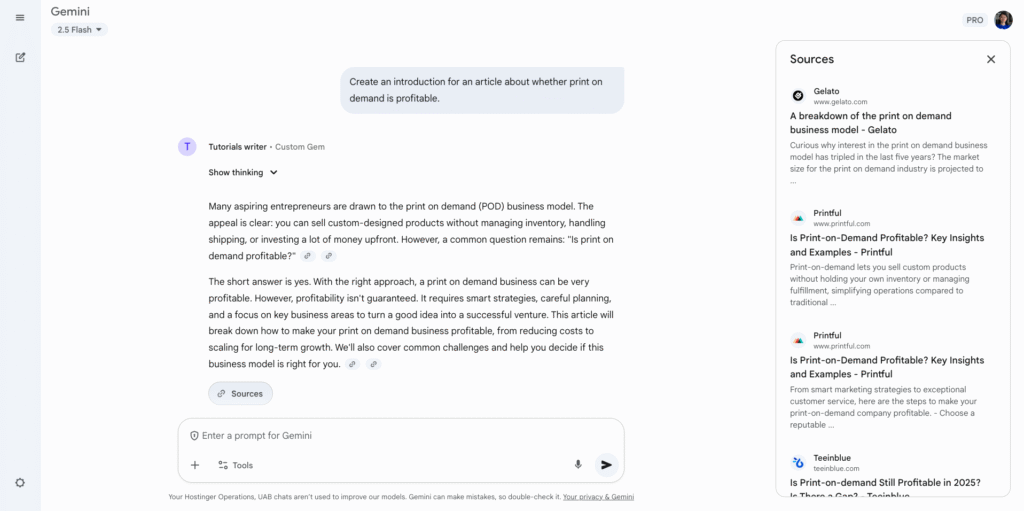
Gemini can help structure blog posts with clear headings, keyword-rich sections, and concise summaries, all within Google Workspace tools like Docs and Sheets. This approach supports Google’s 2025 priorities: answering questions, demonstrating expertise, and user engagement ‒ potentially increasing your chances of ranking.
One of Gemini’s most unique features is its “Gems”. These are custom AI agents you can configure with your own instructions, tone, and goals. Once a Gem is set up, Gemini can follow your preferences without needing to be re-prompted each time.
If you’re working with a specific tone or style guide, creating your own Gem is the best approach. Alternatively, use pre-made Gems for common tasks like brainstorming ideas, editing drafts, writing sales copy, or analyzing customer feedback.
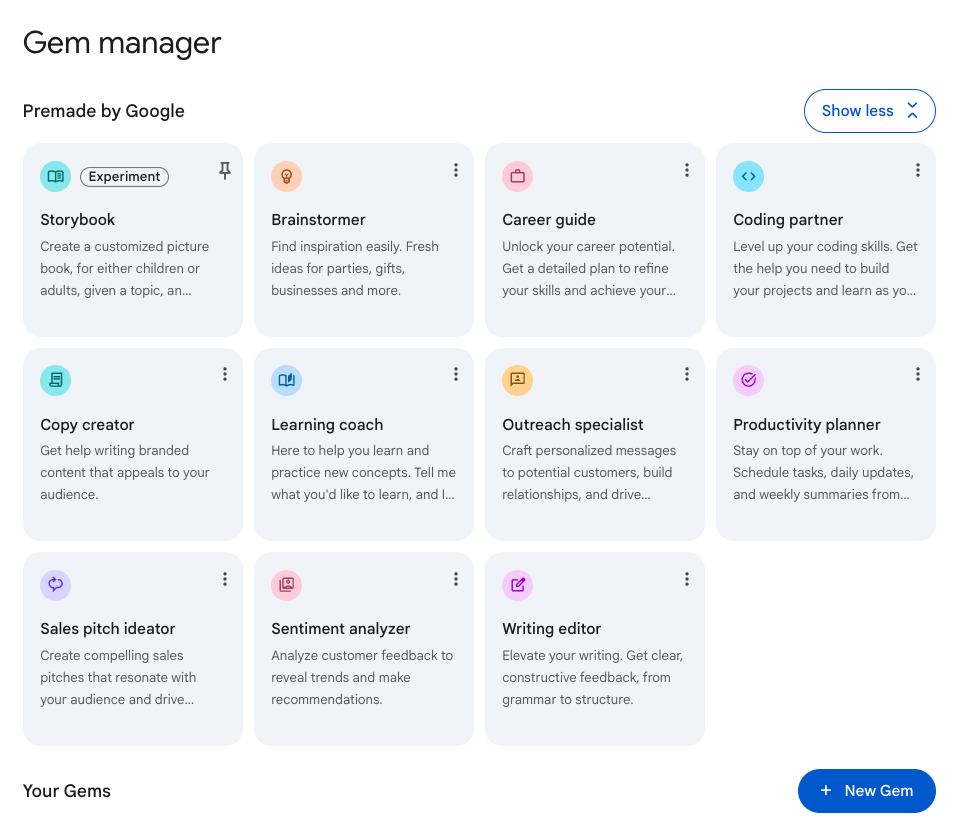
In my testing, I used Gemini to create a blog post on gardening. I opened Google Docs, launched Gemini from the sidebar, and selected a Gem suited for drafting blog content. I provided an outline and a few key points, then reviewed the generated content.
The real-time feedback made it easy to tweak the text on the fly by refining my prompts, which helped improve clarity and flow without having to start over.
Once I was happy with the output, I hit Insert to drop the content straight into my document.
It’s a simple workflow, and a huge perk if you, like me, already do most of your work within the Google Workspace ecosystem.
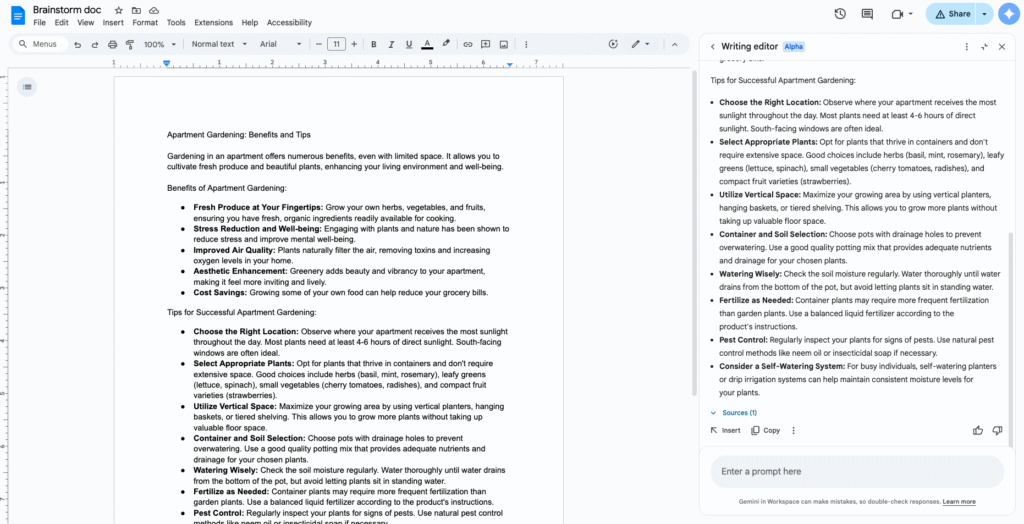
Gemini doesn’t have built-in SEO tools like keyword analysis or content scoring. However, it still supports blogging and SEO by producing structured, research-backed content. You can also create custom Gems to guide content toward specific SEO goals.
If you need more power, Google AI Pro starts at $19.99/month and includes access to Gemini 2.5 Pro, expanded memory, and better coding support. Google AI Ultra, costing $249.99/month, offers advanced video creation tools and enterprise-level features.
| Pros | Cons |
| Real-time access to up-to-date, citation-backed content | Lacks built-in advanced SEO tools |
| Integration with Google Workspace | Requires basic prompt engineering knowledge for accurate complex output |
| Custom AI expert on free and paid versions | Access from Google apps is limited to paid users |
2. Jasper
When I first started using Jasper, I was impressed by how easy it was to navigate, and I could find my way around almost immediately after signing up. It feels powerful without being overly complex, making it stress-free to get started.
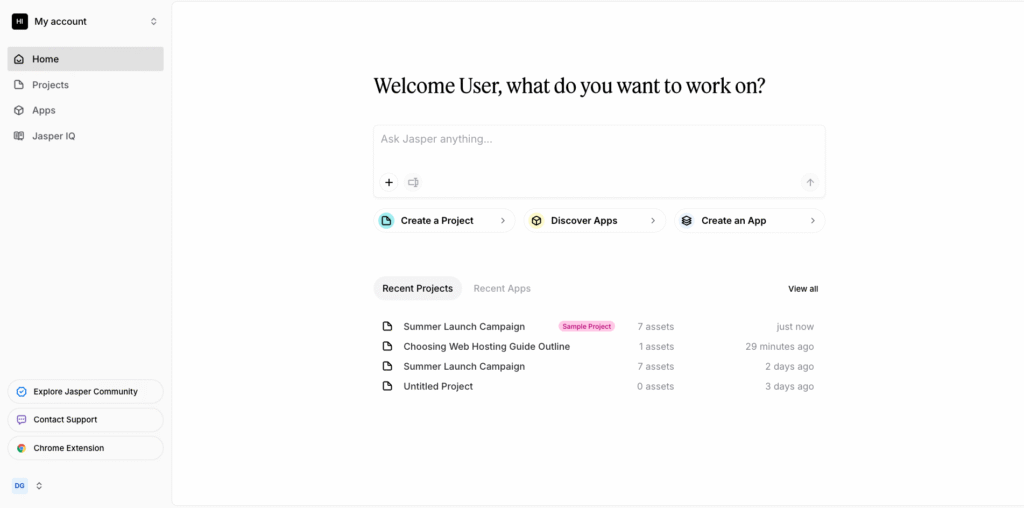
I was pleased to see that Jasper has built-in templates, or “Apps,” for generating content. These templates cover almost every content type I might need, from blog posts and email campaigns to social media content. Business users can create custom Apps tailored to their own workflow.
Each App guides you through the process by asking for key details like titles, language, or keywords. Once Jasper generates the content, you can edit it directly in the editor with basic formatting, comments, version history, and download options.
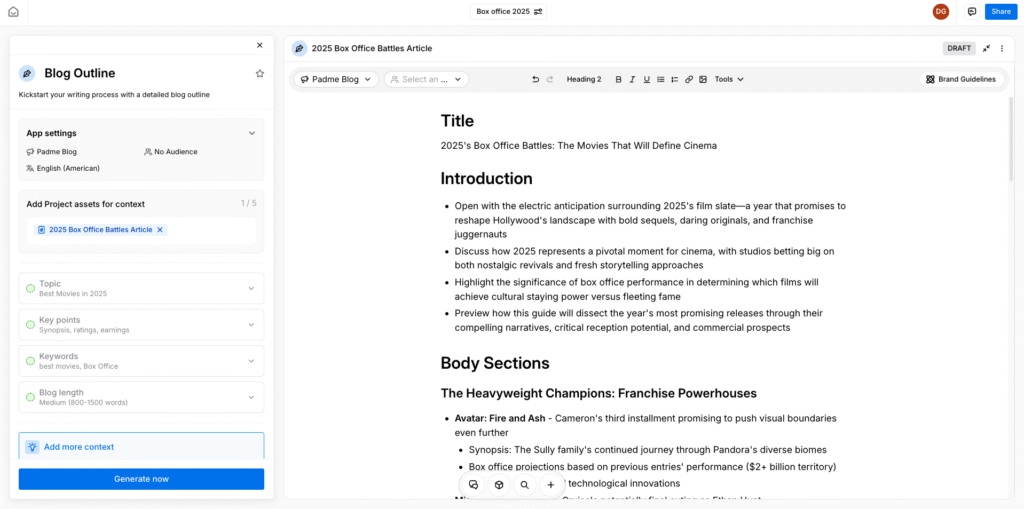
During my testing, I tried the Blog Outline App to structure an article about 2025 box office movies. I gave Jasper the topic, brand voice, and language, and it generated a solid outline with SEO suggestions that I was happy with.
I used the Chat feature to make a few tweaks, and the changes were applied directly in the document editor. It made refining the content much easier than switching between multiple tools.
Jasper’s browser extension quickly became my favorite feature due to its convenience. When I’m working outside the platform, I can quickly highlight text and apply grammar checks, adjust tone, shorten or expand content, translate, or repurpose copy without leaving the page.

The biggest downside is pricing. The Pro plan costs $59/month, while businesses can get a custom quote for additional features like priority support and the no-code AI App Builder. I’d recommend using the seven-day trial to see if it meets your needs before committing to a subscription.
| Pros | Cons |
| Easy-to-use templates for different content types | High starting price; no free plan |
| Supports 30+ languages | AI App Builder and project sharing are only available for Business plan users |
| Intuitive brand voice management | Plagiarism detection is an add-on, charged separately per check |
Best affordable and beginner-friendly AI writers
1minAI and Rytr strike a balance between cost-effectiveness and advanced features, great options for anyone just starting out or working on a tight budget. Both tools start at less than $10/month, which is a bargain considering the range of AI features and the quality of output they provide.
3. 1minAI
1minAI uses credits to manage usage. The good news is that you can get started right away with the credits provided upon signing up.
Credits top up with daily visits, leaving reviews, or referrals, allowing you to experiment with the platform without committing to a paid plan immediately. Upgrading to a paid plan starting at $6.50/month gives you more monthly credits, which I recommend for tackling larger projects more efficiently.
1minAI offers access to multiple AI models including Claude, GPT, Llama, and Gemini. Each task shows how many credits it will cost depending on the AI model you choose.
For example, I can save credits by using Claude 4 Sonnet for generating large volumes of content and spend more on Claude Opus for complex code analysis. This makes it simple to balance cost with task complexity and ensure I’m using the right model for each project.
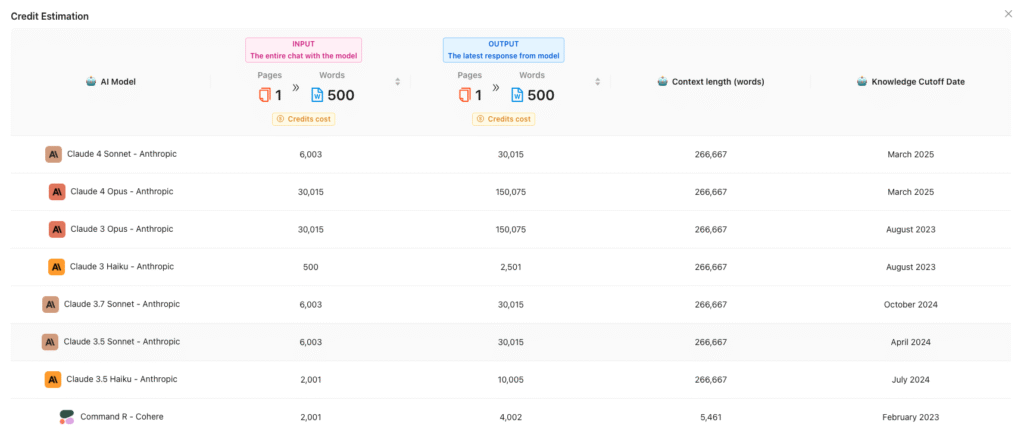
You’ll want to keep those credits topped up since 1minAI offers access to multiple AI models for a variety of content types. Generate text, audio, video, image, and even code within the same platform. Just remember that resource-intensive tasks like generating videos use a lot of credits.
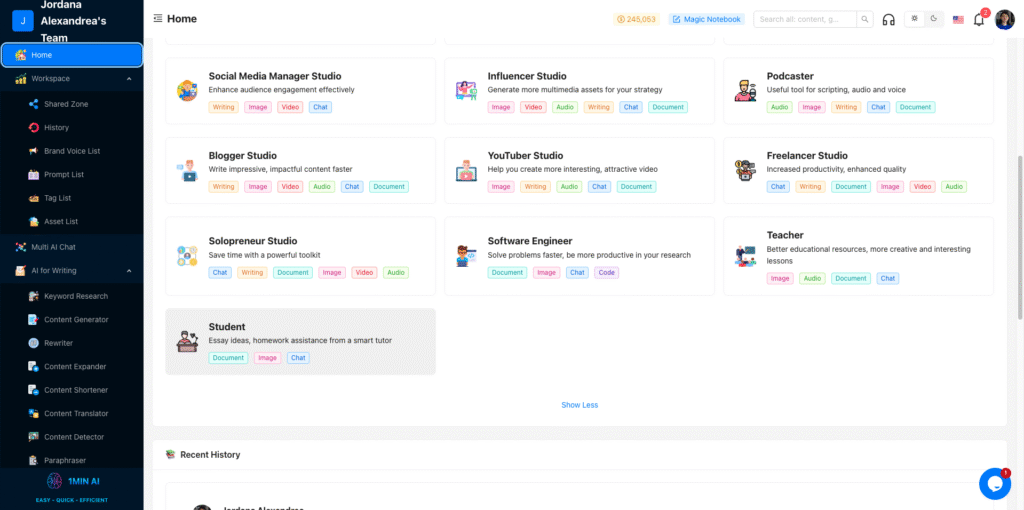
One small but crucial feature that wins it for me is the Magic Notebook. It lets you compile all your writing and creative assets from different AI models in a single pop-up editor. There’s no need to juggle multiple windows or tabs, which makes drafting, editing, and organizing content more efficient.
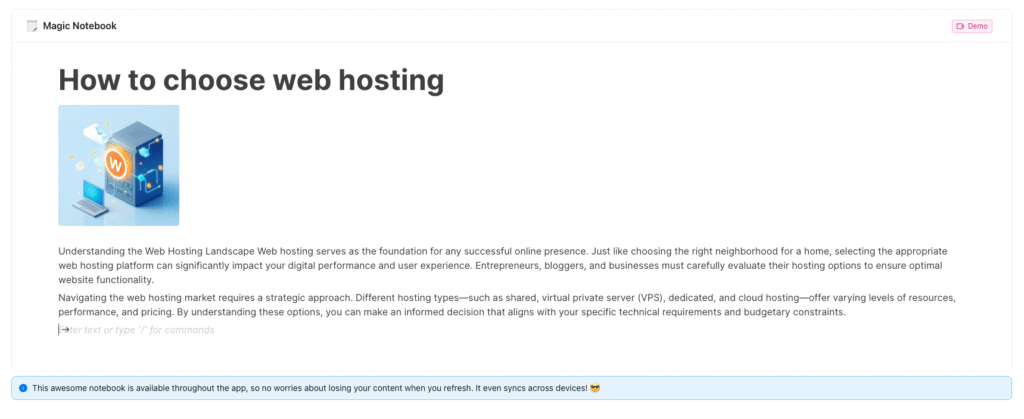
Different tasks use different amounts of credits, and in my experience, it takes at least five prompts to put together a solid article with visuals. If I’m not careful, it’s easy to burn through my daily credits quickly. That’s why for larger or more complex projects, having a steady allocation of monthly credits makes the paid plan worth it.
| Pros | Cons |
| Different ways to obtain free credits | Paying users could still run out of credits on large, complex projects |
| Access to multiple AI models, such as GPT-4, Gemini, and Claude | Newer AI models use more credits |
| Multi-tasking editor for task switching | Shorter knowledge cutoff dates on older AI models |
4. Rytr
One of the things I like most about Rytr is its unique tones of voice. I can choose from styles like humorous, appreciative, or urgent, and the results don’t feel robotic. The output usually requires minimal editing, so it gives me a solid foundation to work from rather than starting entirely from scratch.
I also appreciate the handy toolbar in the rich text editor. From there, I can check for plagiarism, adjust content length, or generate new ideas without leaving the editor. It’s small features like this that make drafting, editing, and refining content feel seamless.
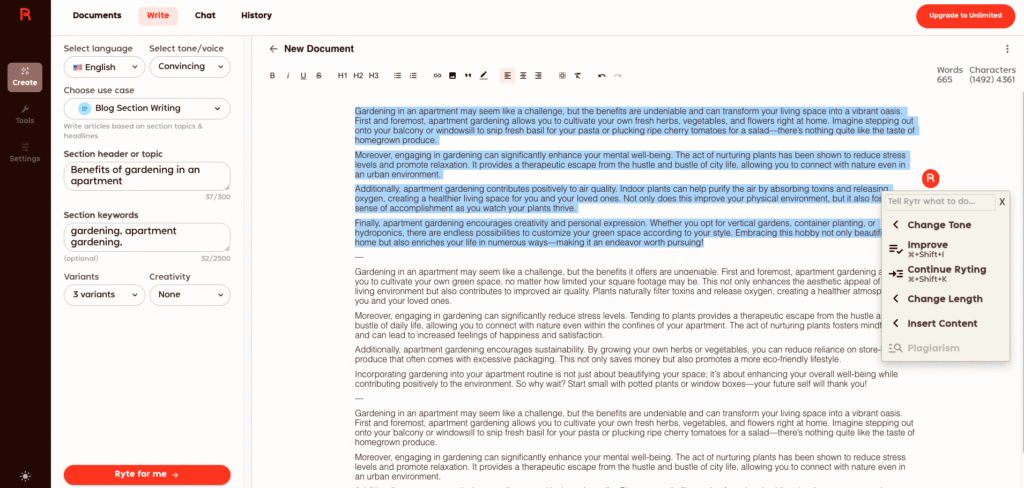
Rytr also has a chat feature, which is perfect for quick prompts, brainstorming, or iterating on ideas. For work outside the platform, the browser extension makes it easy to create or edit content wherever you need it.
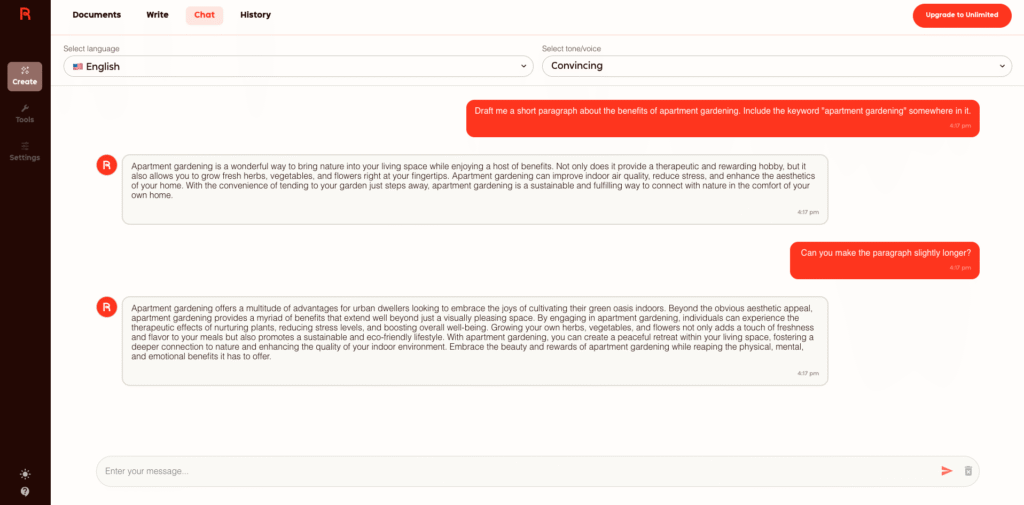
Rytr supports over 30 languages, including both RTL and LTR scripts. The language picker makes it easy to switch, which is handy for creating multilingual content. However, this feature is only available on the Premium plan ($24.16/month), the platform’s highest-tier option.
The free plan is capped at 10,000 characters per month, which is fine for testing and experimenting with prompts. In my experience, that limit can run out quickly if I’m producing content weekly, let alone daily. Therefore, it’s really only suited for small projects or trying out different ideas before upgrading to a paid plan.
Given the big upgrade in features and capabilities, I think upgrading to Premium provides better value than the Unlimited plan ($7.50/month).
| Pros | Cons |
| Free plan available | Can only generate 10,000 characters monthly |
| Rich text editor with formatting, history, downloads | Only Premium plan users can create custom tone of voices and use cases |
| Chat feature and browser extension for flexible workflows | Plagiarism check is a paid feature |
5. Hostinger AI Writer
I included Hostinger AI Writer on this list because it solves a specific yet common challenge: launching a new website with optimized content already in place.
This AI content generator is built directly into Hostinger’s site builder. For $2.75/month, you can access it during setup. Just describe the purpose of your website, and the tool automatically fills all the pages with relevant, SEO-friendly content.
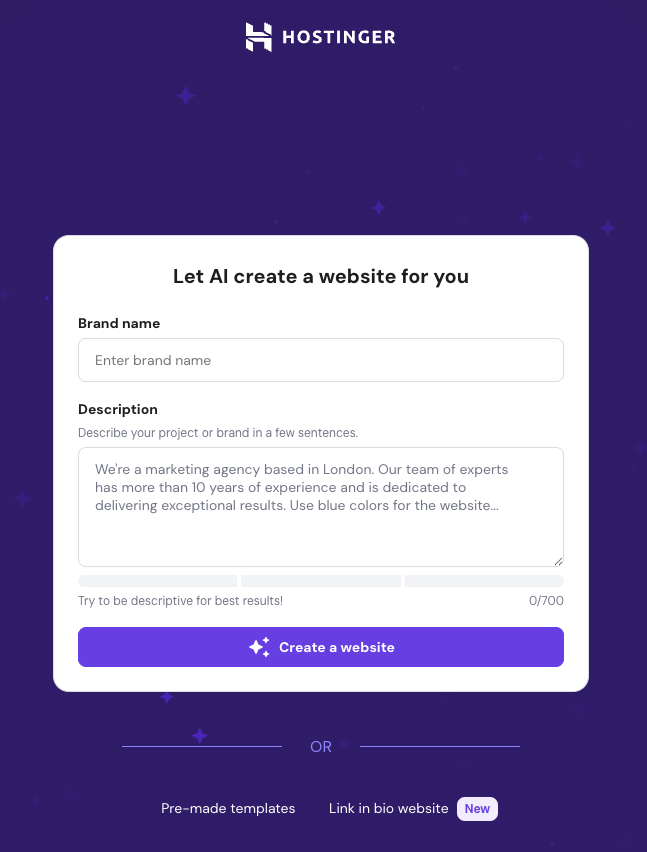
You can also use AI Writer within the page editor as a premium feature. To generate text from scratch, open the tool from the sidebar and enter a prompt. Or, hover over any text element to rewrite or improve the content directly.
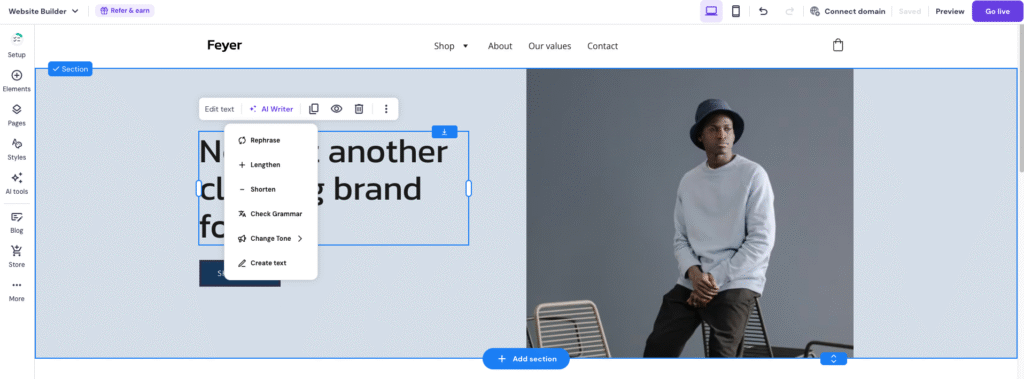
Because it’s built into the Hostinger platform, AI Writer performs best when used for its intended purpose. It can handle short, simple prompts about the topic and length of the content. Once the content is generated, you can copy or import it into the editing element without switching tabs or tools.
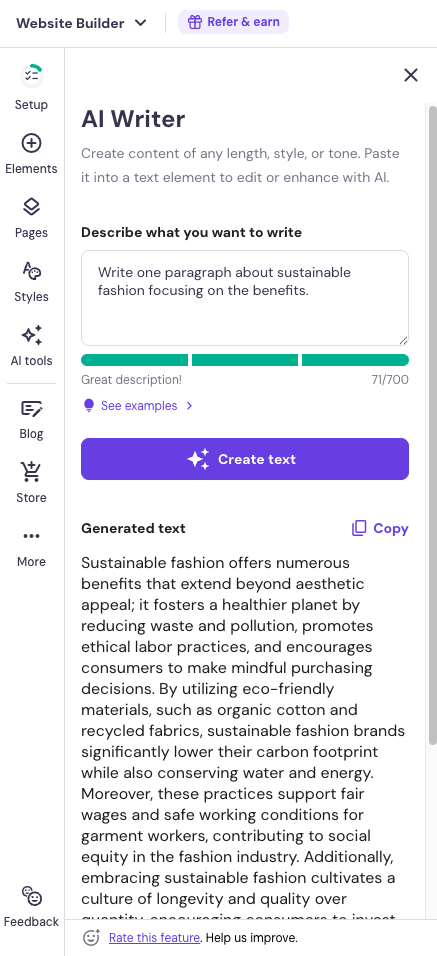
One limitation to note is that the tool only accepts one prompt at a time. You can’t tweak the output by giving feedback or asking for variations, so any changes or rewrites need to be done manually.
Overall, it’s a practical tool for generating short-form website or product page copy. For long-form content like blog articles, I’d recommend using its companion tools: AI Blog Generator or AI Content Creator included with Hostinger’s WordPress business plan.
| Pros | Cons |
| Fully integrated into Hostinger’s website builder and editor | Only available to Hostinger users |
| Beginner-friendly, no separate setup or learning curve | Output may still require human editing |
| Customizable tone of voice | Accept single prompts |

Best general-purpose AI writers
ChatGPT and Claude show great adaptability across different marketing tasks during testing. These tools handle almost any writing task and are great at reasoning and deep research, earning their spots as the best general-purpose AI writers.
6. ChatGPT (OpenAI)
One of the things I like most about ChatGPT is how naturally it understands my prompts. Its large language model (LLM) GPT is advanced enough to follow instructions in a conversational tone, so I don’t have to phrase everything perfectly or rely on complex prompt engineering.
What’s even more helpful is that when it can’t fulfill a prompt exactly as I imagined, ChatGPT often suggests alternative ways to approach it.
For example, if I ask it to draft a specific email campaign and it detects gaps in the information, it will propose different angles, structures, or subject lines. This makes the content creation process feel more collaborative, like I’m brainstorming with a colleague who understands my goals.
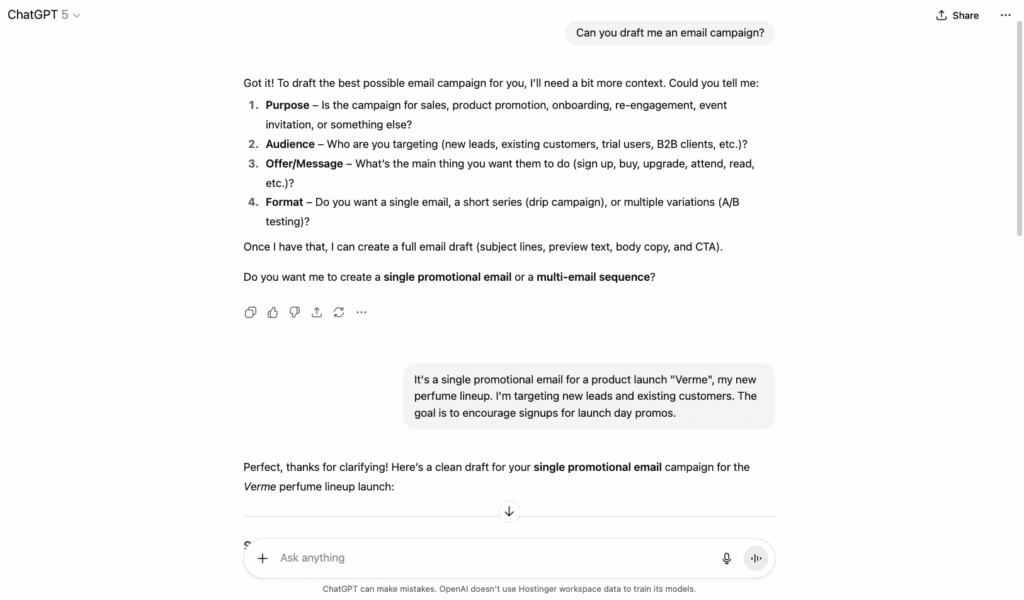
Thanks to its memory feature, ChatGPT can provide details across sessions, such as my preferences, ongoing projects, or writing style. I soon noticed that the more I use it with memory enabled, the better it tailors its responses to my needs, making content more aligned with my usual workflows. I was able to review or delete saved memories at any time in the settings.
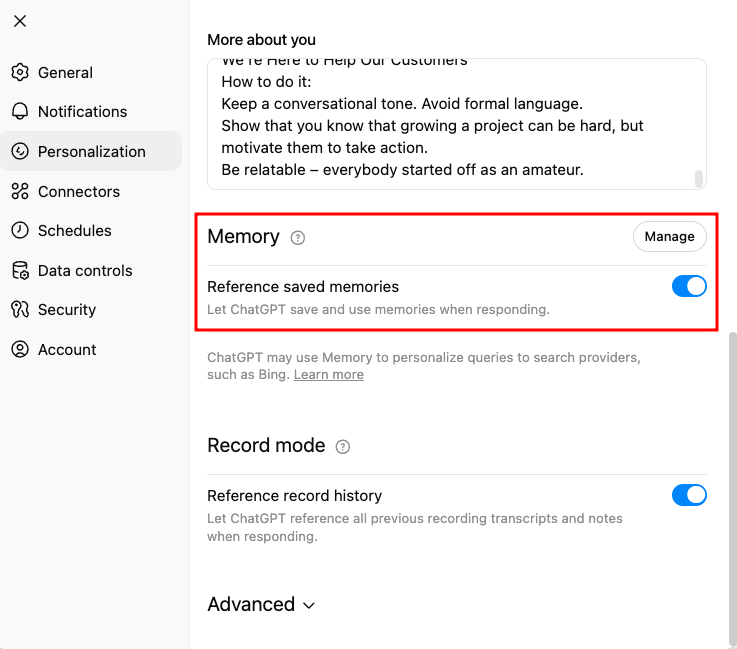
Another feature I found really useful is image generation. You can upload an image to modify it or start from scratch, like I did with the example below (I was quite happy with the result). This adds extra value to content marketing projects by letting you pair visuals with AI-written text in a single platform.
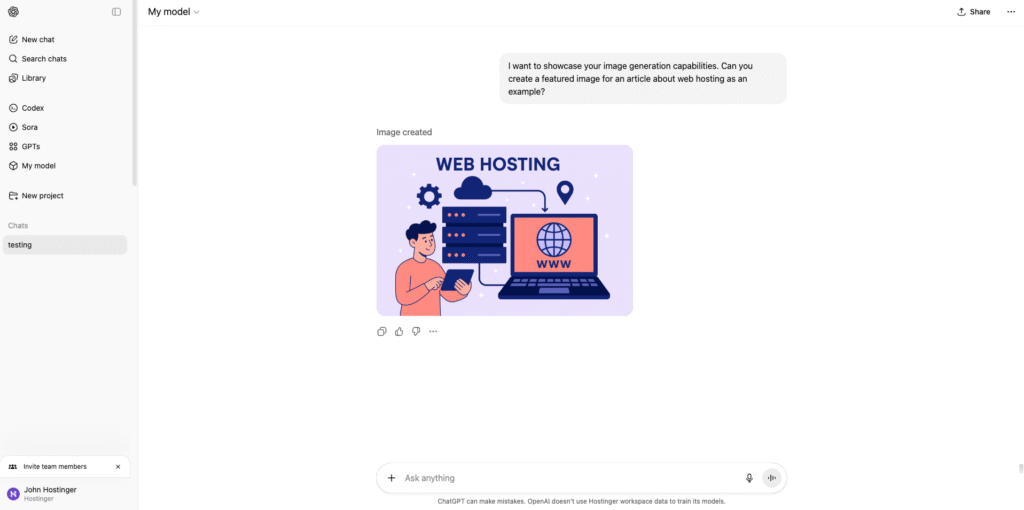
And if you want to stay organized, ask ChatGPT to automate prompts for tasks like reminders or quick searches. For example, in a test chat, I set up a reminder for one minute later, and ChatGPT pinged me right on time (just make sure notifications are enabled). This feature is helpful for keeping track of deadlines and managing content planning.
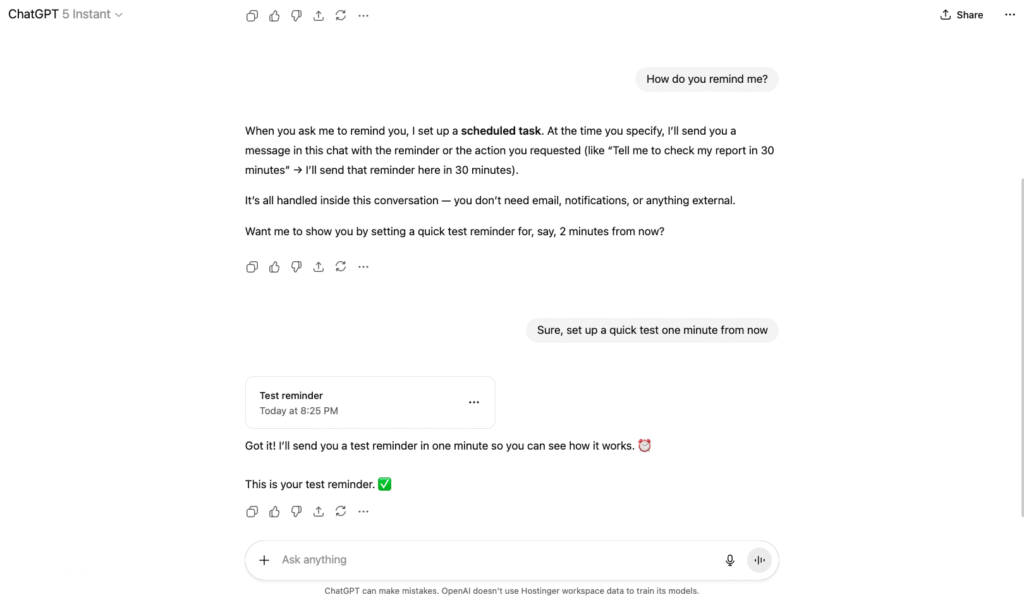
Even though the free plan has usage limits and can feel slower at times, it still offers real-time web access to help produce up-to-date content. Paid plans start at $20/month for Plus and go up to $200/month for Pro, which also lets you create your own custom GPTs.
| Pros | Cons |
| Real-time web access and unlimited chat history on all plans | Free and Pro users’ data is used for training by default unless you opt out manually |
| Can handle complex tasks (e.g. deep research, logical reasoning, coding, image analysis) | Requires prompt engineering for better results |
| Vast integrations with repositories and work tools | Unlimited access to GPT-5 (the latest-generation LLM) is exclusive to Pro and Business plans |
7. Claude
I first heard about Claude from developers in my team, who were using it for testing and troubleshooting code. It turns out Claude is also great for generating blog posts, emails, and creative copy.
For example, when I asked Claude to generate a newsletter, it created both the content and the HTML formatting scripts, which saved me quite a bit of time.
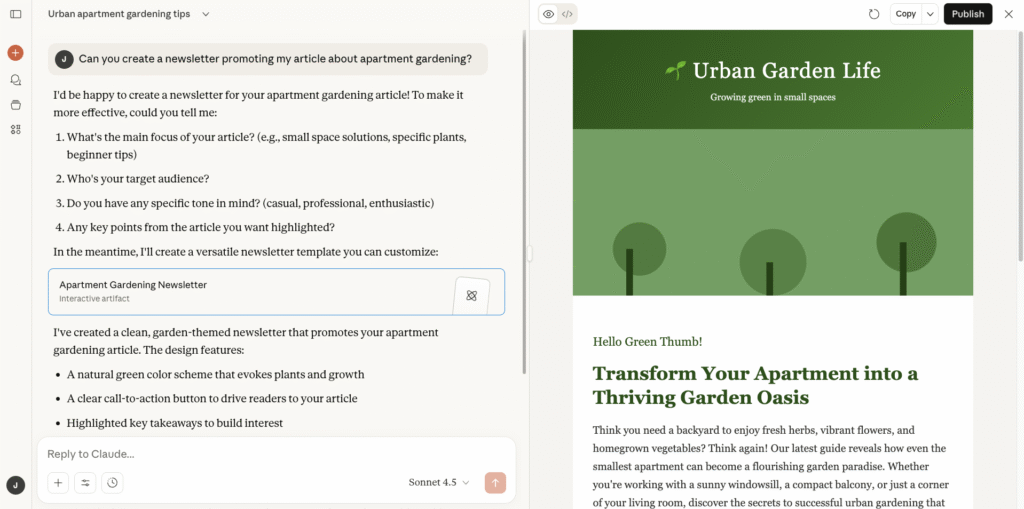
I like that the option to opt out of using my data for training is offered right at the setup stage. Many AI tools hide this setting in menus, so having it upfront is reassuring and avoids the hassle of digging through the platform. Claude also offers an incognito mode, which prevents chats from being saved to history or used for model training.
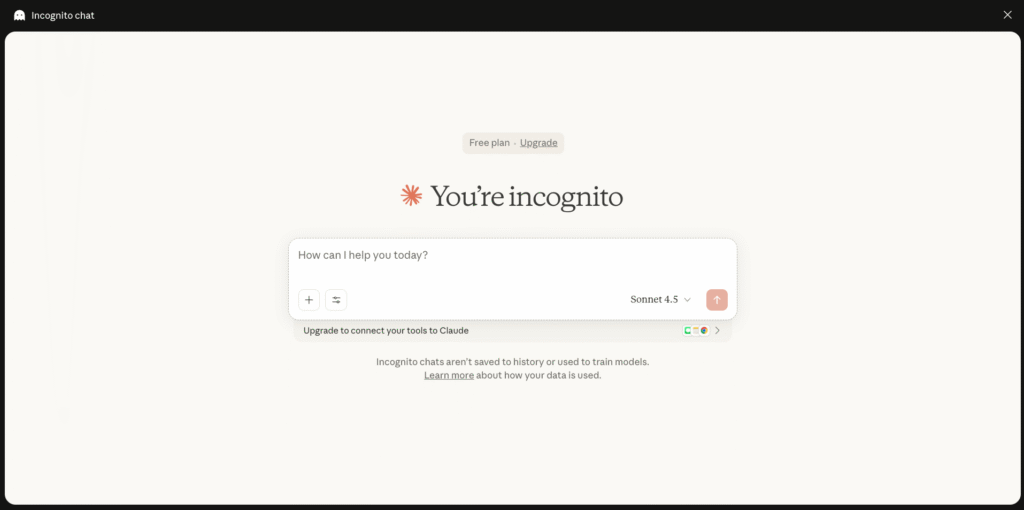
What makes Claude stand out is its Artifacts feature. Artifacts show content like code, documents, or apps in a separate panel, letting you view, edit, and reuse them without cluttering your conversation.
I tested the Writing Editor Artifact, and it’s incredibly intuitive. I could check grammar, spelling, and punctuation, and with a single click, apply all suggested changes with the built-in feature.
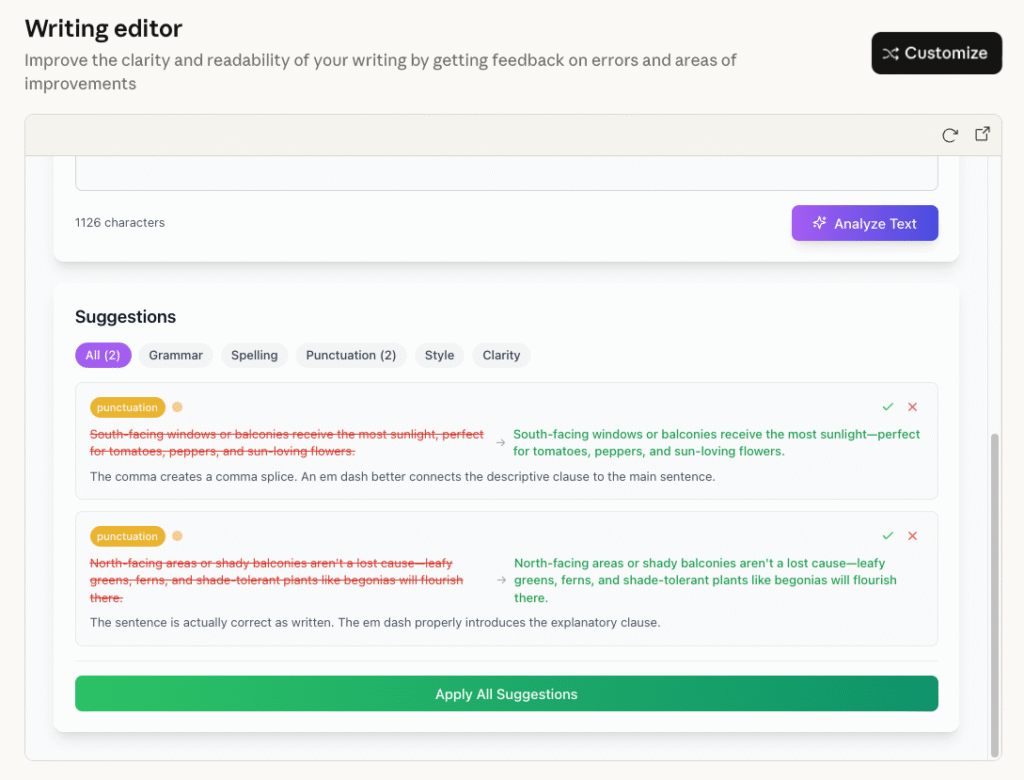
Claude handles conversational prompts exceptionally well, similar to ChatGPT. It can remember context and references within the same project, so I don’t have to re-explain everything when refining content. To start a separate task, I simply open a new chat, keeping projects organized without losing continuity.
It also handles images (you can upload screenshots) and integrates with apps like Google Drive, Canva, and Figma for visual-based projects. This makes it easy to incorporate visuals into my projects.
The default knowledge cutoff is nine months, so you’ll need to prompt it for recent web information. The good news is Claude includes sources, making it easy to verify the information.
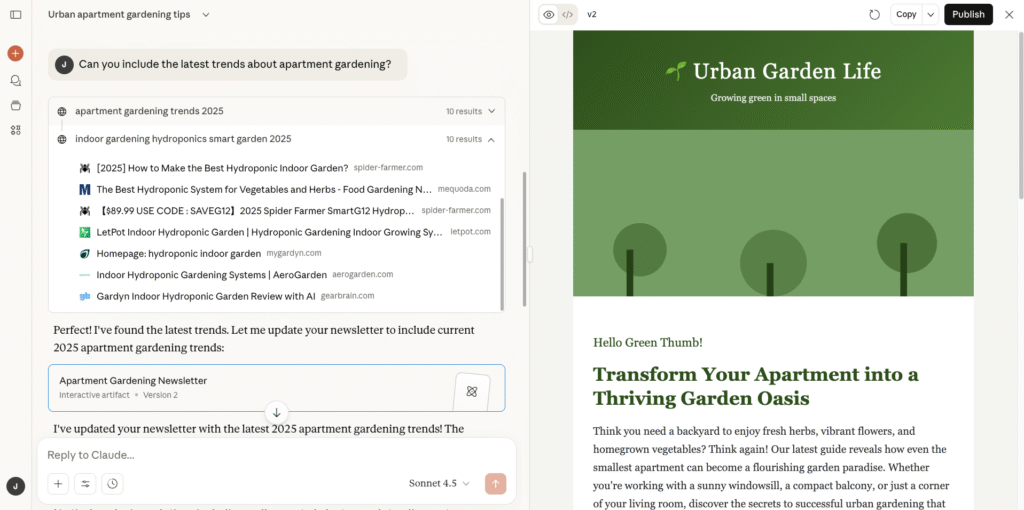
The free plan has usage limits that resets every five hours, which is ideal for smaller projects that don’t require extensive research. Paid plans start at $17/month, offering features like Google Workspace integration, Claude Code for coding assistance, and extended thinking for complex tasks..
| Pros | Cons |
| Privacy settings are clearly notified upon signing up | Limits session-based usage to around 100 messages (reset every five hours) |
| Ability to upload screenshots and link to GitHub repositories | Voice input is only available in the mobile app (and in some regions on web and desktop) |
| Integrations with remote and local tools (e.g. Google Workspace, Asana, Canva, Figma, Zapier) | Extended thinking mode requires a paid plan |
How to choose the right AI content generator
Choosing the right content AI tool can make a big difference in how efficiently you create content and reach your goals. When evaluating AI writers, focus on these key factors that can help you find the best fit for your needs, whether it’s AI SEO content writing, social media posts, or marketing copy.
Here’s how to decide.
1. Evaluate your budget
Free tiers in tools like ChatGPT and Claude are surprisingly capable, letting you generate solid content quickly. However, they hit usage limits fast if you’re creating multiple pieces in a week.
Meanwhile, tools that use a credit system like 1minAI are be cost-effective for small projects, but they’re less practical for complex content that requires multiple refinements.
From my experience, if you’re producing more than three or four pieces of content weekly, it’s worth upgrading and budgeting for at least a $20/month plan to maintain efficiency and avoid hitting limits.
2. Pick based on content type
Tools that can handle two-way communication and conversational prompts, like ChatGPT and Claude, are ideal for long-form, in-depth content ‒ blog posts, articles, or research-heavy pieces ‒ because I can refine the output on the fly.
On the other hand, tools that rely on simpler prompts work well as thought-starters for short marketing copy, social posts, or brainstorming sessions.
When choosing a tool, think about the content you create most often so you can pick one that makes those workflows as smooth as possible.
3. Consider the ease of use
From my experience, the easier a tool is to navigate, the more I can focus on creating content rather than figuring out the platform.
I look for intuitive interfaces, pre-built templates, and integrations with tools I already use ‒ like Google Docs, WordPress, or Canva ‒ because they let me move seamlessly between research, drafting, and publishing.
Features like a rich text editor with inline AI functions, shortcut keys, or pop-up toolbars can save you minutes (or hours) every day, especially when working on multiple projects. The browser extension format also makes the tool easily accessible whenever you need to jot down ideas or add extra information.
4. Aim for accuracy and originality
To find the best AI writing tool for your workflow, pay close attention to how accurate and original the content is.
Some tools include plagiarism detection as a built-in feature, while others only offer it in paid plans. It’s worth checking which subscription level you need if originality is important for your work.
I also consider the AI’s knowledge cutoff. Even tools with web access, like Claude, still need to be prompted to search for the latest information if the model’s base knowledge is capped.
Making sure the AI content is both accurate and unique helps save time on edits and ensures your posts or marketing materials maintain credibility.
5. Account for scalability
Think about whether you’re a solo creator or running a team or business. Having the right tool for your scale of work makes a huge difference in staying organized, managing multiple contributors, and keeping projects moving efficiently.
Tools like Rytr, 1minAI, and Hostinger AI Writer work really well for individual creators. They’re straightforward, affordable, and perfect for producing content on your own.
On the other hand, if you need collaboration features, shared workflows, or enterprise-level tools, you might be better off with ChatGPT, Gemini, or Claude.
Are there any limitations to AI content generators?
AI content generators are powerful, but they’re not perfect. Since they rely on existing data and patterns, they can sometimes struggle to produce fully factual, up-to-date, or completely original content. This is especially true for tools without real-time web access, as they can’t retrieve or cross-check the latest information.
For example, Claude sometimes falsely flags claims because its knowledge is limited to its cutoff date, requiring users to double-check statements.
Context is another important factor. AI can misinterpret prompts or generate content that seems fine at first glance but contains subtle errors, inconsistencies, or repeated phrases.
In my experience, Rytr’s first attempt often sounds marketing-like, and some sections can be repetitive, so I usually need to refine the output. Even ChatGPT and Gemini occasionally forget my preferences for formatting when a chat gets especially long, which can disrupt continuity when working on multi-step projects.
Because of these limitations, AI content generators work best as drafting assistants. They handle the first draft quickly, help brainstorm ideas, and generate structure, but human review, fact-checking, and editing are still essential to ensure accuracy and maintain quality.
Can AI-generated content rank on Google?
Technically, AI-generated content can rank on Google. However, in my experience, most AI drafts don’t meet Google’s quality standards without some serious human editing. Google won’t penalize AI content, but it does penalize content lacking expertise, original insights, and value ‒ elements raw AI output often misses.
To actually get AI content to rank, I focus on structuring it clearly, using relevant keywords naturally, making sure it’s original, and keeping it easy to read. Even when AI handles the first draft, I usually spend time refining it so it truly meets user needs and search intent.
For a deeper dive, our SEO audit guide covers step-by-step tips for improving your chances of ranking with AI-generated content.
How do AI content detectors work?
AI content detectors analyze text to identify patterns that suggest it was generated by an AI model. They look at features like sentence structure, word choice, repetition, and the likelihood of certain word sequences to determine if the content is human-written or AI-generated.
That said, these tools can produce false positives (flagging human-written content as AI) or false negatives (missing AI content). Many detectors include a disclaimer, letting users know the results aren’t absolute and it’s recommended to use your own judgment when reviewing content.
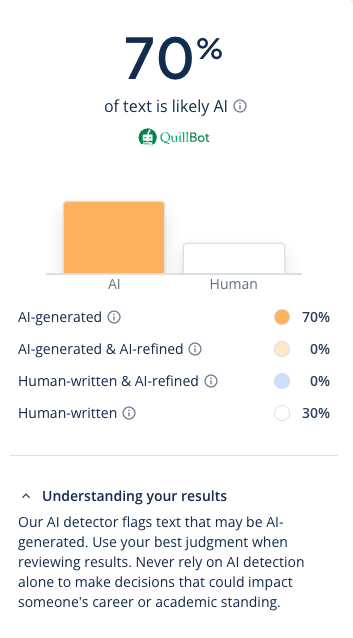
For this reason, I’d recommend using AI content detectors as a guide rather than a final verdict.
Which AI content generator should you use?
Which AI tool is right for you really depends on what you’re trying to achieve. If your focus is SEO and long-form content, I’d go with Gemini, Jasper, or ChatGPT. These tools are great for creating blog posts, articles, and other content meant to rank well in search engines, thanks to their research features and SEO-friendly workflows.
If you’re a small business or just getting started, tools like Hostinger AI Writer, Claude, 1min AI, or Rytr are solid choices. They’re beginner-friendly, affordable, and perfect for generating short-form marketing copy or simple web content without getting too complicated.
Whatever you choose, make sure to take advantage of free plans or trials when available. It’s the best way to test the platform, get comfortable with the interface, and see if it really fits your workflow before committing to a paid plan.
All of the tutorial content on this website is subject to Hostinger's rigorous editorial standards and values.



